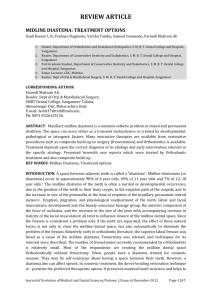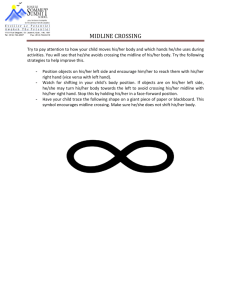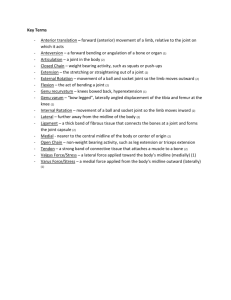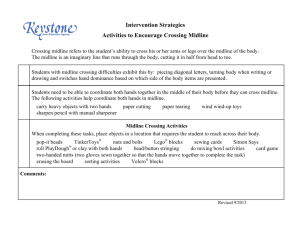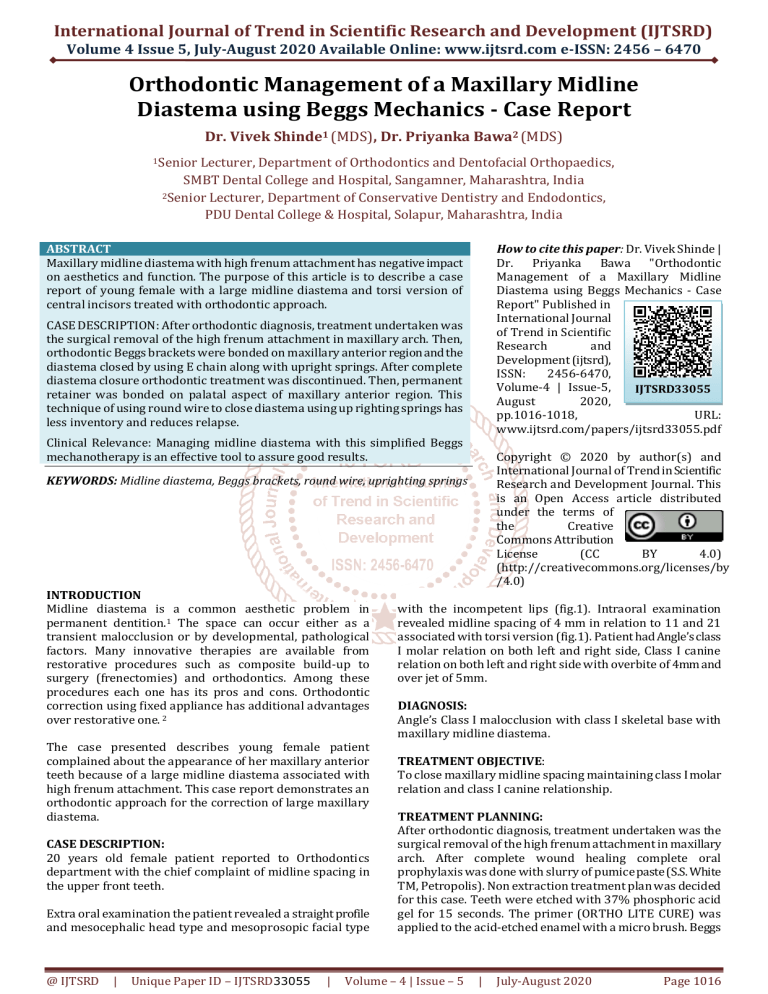
International Journal of Trend in Scientific Research and Development (IJTSRD)
Volume 4 Issue 5, July-August 2020 Available Online: www.ijtsrd.com e-ISSN: 2456 – 6470
Orthodontic Management of a Maxillary Midline
Diastema using Beggs Mechanics - Case Report
Dr. Vivek Shinde1 (MDS), Dr. Priyanka Bawa2 (MDS)
1Senior
Lecturer, Department of Orthodontics and Dentofacial Orthopaedics,
SMBT Dental College and Hospital, Sangamner, Maharashtra, India
2Senior Lecturer, Department of Conservative Dentistry and Endodontics,
PDU Dental College & Hospital, Solapur, Maharashtra, India
ABSTRACT
Maxillary midline diastema with high frenum attachment has negative impact
on aesthetics and function. The purpose of this article is to describe a case
report of young female with a large midline diastema and torsi version of
central incisors treated with orthodontic approach.
How to cite this paper: Dr. Vivek Shinde |
Dr. Priyanka Bawa "Orthodontic
Management of a Maxillary Midline
Diastema using Beggs Mechanics - Case
Report" Published in
International Journal
of Trend in Scientific
Research
and
Development (ijtsrd),
ISSN:
2456-6470,
Volume-4 | Issue-5,
IJTSRD33055
August
2020,
pp.1016-1018,
URL:
www.ijtsrd.com/papers/ijtsrd33055.pdf
CASE DESCRIPTION: After orthodontic diagnosis, treatment undertaken was
the surgical removal of the high frenum attachment in maxillary arch. Then,
orthodontic Beggs brackets were bonded on maxillary anterior region and the
diastema closed by using E chain along with upright springs. After complete
diastema closure orthodontic treatment was discontinued. Then, permanent
retainer was bonded on palatal aspect of maxillary anterior region. This
technique of using round wire to close diastema using up righting springs has
less inventory and reduces relapse.
Clinical Relevance: Managing midline diastema with this simplified Beggs
mechanotherapy is an effective tool to assure good results.
Copyright © 2020 by author(s) and
International Journal of Trend in Scientific
Research and Development Journal. This
is an Open Access article distributed
under the terms of
the
Creative
Commons Attribution
License
(CC
BY
4.0)
(http://creativecommons.org/licenses/by
/4.0)
KEYWORDS: Midline diastema, Beggs brackets, round wire, uprighting springs
INTRODUCTION
Midline diastema is a common aesthetic problem in
permanent dentition.1 The space can occur either as a
transient malocclusion or by developmental, pathological
factors. Many innovative therapies are available from
restorative procedures such as composite build-up to
surgery (frenectomies) and orthodontics. Among these
procedures each one has its pros and cons. Orthodontic
correction using fixed appliance has additional advantages
over restorative one. 2
The case presented describes young female patient
complained about the appearance of her maxillary anterior
teeth because of a large midline diastema associated with
high frenum attachment. This case report demonstrates an
orthodontic approach for the correction of large maxillary
diastema.
CASE DESCRIPTION:
20 years old female patient reported to Orthodontics
department with the chief complaint of midline spacing in
the upper front teeth.
Extra oral examination the patient revealed a straight profile
and mesocephalic head type and mesoprosopic facial type
@ IJTSRD
|
Unique Paper ID – IJTSRD33055
|
with the incompetent lips (fig.1). Intraoral examination
revealed midline spacing of 4 mm in relation to 11 and 21
associated with torsi version (fig.1). Patient had Angle’s class
I molar relation on both left and right side, Class I canine
relation on both left and right side with overbite of 4mm and
over jet of 5mm.
DIAGNOSIS:
Angle’s Class I malocclusion with class I skeletal base with
maxillary midline diastema.
TREATMENT OBJECTIVE:
To close maxillary midline spacing maintaining class I molar
relation and class I canine relationship.
TREATMENT PLANNING:
After orthodontic diagnosis, treatment undertaken was the
surgical removal of the high frenum attachment in maxillary
arch. After complete wound healing complete oral
prophylaxis was done with slurry of pumice paste (S.S. White
TM, Petropolis). Non extraction treatment plan was decided
for this case. Teeth were etched with 37% phosphoric acid
gel for 15 seconds. The primer (ORTHO LITE CURE) was
applied to the acid-etched enamel with a micro brush. Beggs
Volume – 4 | Issue – 5
|
July-August 2020
Page 1016
International Journal of Trend in Scientific Research and Development (IJTSRD) @ www.ijtsrd.com eISSN: 2456-6470
brackets were bonded on maxillary anterior teeth using light
cured transbond composite resin and polymerized with the
help of LED light curing unit (3M ESPETM Elipar S10).
Initial alignment and leveling phase of treatment was
completed using A J Wilcock stainless steel 0.016” wire along
with lingual buttons bonded on palatal surface of 11 and 12.
E-Chain was attached from lingual button to central incisor
bracket on the opposite side to correct torsi version of
incisors (fig.2). The torsi version was corrected by couple
mechanics generated from lingual button to Beggs bracket
on opposite side. Midline space closure was decided to be
done using elastomeric chain and up righting springs (fig.3,
4). After complete midline space closure, permanent retainer
was bonded on palatal aspect of maxillary anterior region for
the retention purpose (fig.5).
Up righting Spring
This spring was fabricated using 0.014 SS wire which
contains helix with diameter of 3mm. The active arm is bent
at 45° inward and downward, such that during activation the
active arm rests completely on the arch wire (Fig 4).
TREATMENT PROGRESS
The treatment duration for closing of midline diastema was
eight weeks (Fig 6). After eight weeks, IOPA was taken for
the central incisors to check for the space closure and root
paralleling.
DISCUSSION
The management of the midline diastema depends upon
their etiology.1 Wider diastema needs closure by fixed
appliance for the correcting and controlling crown and root
angulations .2,3
Up righting spring can reduce mesial crown tipping during
diastema closure. However, a 2x4 appliance or utility arch
can provide better vertical and torque control of incisors
during closure of midline diastema and can also retract
incisors. 4 Longer up righting spring made to apply a force
more apically above cemento-enamel junction, closer to
center of resistance of the tooth to enable more moment to
force ratio. Large diastema closure with force applied at the
bracket level leads to mesial tipping of crowns. Teeth tipped
in such a manner remain unstable. This results in diastema
recurrence by relapse over a period of time. Hence, the
uprighting sprigs were used to move central incisors bodily.
Beggs brackets with up righting springs uses differential
force system which ultimately carried out tooth movement
faster with minimum trauma to surrounding periodontium. 1,
4
Treatment of diastema varies and it requires correct
diagnosis of its etiology, and early intervention relevant to
the specific etiology. 5 There are many techniques available
in the field of orthodontics to close the midline space using
various materials; most of the techniques have resulted in
relapse. Various materials to close the midline space are
closed coil spring, different types of wire, wires with
different cross sections, etc. 6,7
Orthodontists usually encounter the challenges with relapse
after treating midline diastema. Closure of the maxillary
midline diastema with a prominent frenum is more
@ IJTSRD
|
Unique Paper ID – IJTSRD33055
|
predictable with frenectomy and concomitant orthodontic
treatment than with frenectomy alone. 8
This article describes case treated with Beggs brackets with
up righting spring for maxillary midline diastema. Tipping
movement of the central incisors in mesial direction using
round wire has a better tooth control compared to the
rectangular wire technique. Round wire resulted in tipping
movement with no root parallelism which was achieved by
using up righting springs. This technique is less invasive
because it controls the both tipping and root up righting.
The median diastema have a tendency to recur after their
closure.5 Hence, a lingually bonded fixed retainer is
recommended.5 Edwards 9found diastema relapse in 84% of
his sample with a correlation between labial frenum and
diastema relapse. Another study found midline diastema
recurrence in 60% of the sample with stronger correlation of
relapse with larger initial diastema width, relapse of overjet,
and intermaxillary osseous cleft and concluded that midline
diastema closure is highly unstable; hence, needs lifetime
wear of maxillary fixed retainer.10
CONCLUSION
Large median diastema causes psychological concerns
among adult patients and requires closure by bodily
movement of central incisors. Uprighting springs with round
wire is a better way of treating midline diastema in which
the occurrence of relapse can be reduced because of bodily
movement of the tooth in mesial direction.
REFERENCES
[1] Bishara SE. Management of diastemas in orthodontics.
Am J Orthod. 1972 Jan; 61(1):55–63.
[2] Becker A. The median diastema. Dent Clin North Am.
1978; 22:685–710.
[3] Broadbent BH. The face of a normal child (diagnosis,
development). Angle Orthod. 1937; 7:183–208.
[4] Proffit WR. Fields HW. Contemporary orthodontics. 4th
ed. Mosby; 2007. pp. 99–100.
[5] Huang WJ, Creath CJ. The midline diastema: a review of
its etiology and treatment. Pediatr Dent. 1995 Jun;
17(3):171–179.
[6] Brunelle JA, Bhat M, Lipton JA. Prevalence and
distribution of selected occlusal charecteristics in the
US population 1988-1991. JDR. 1996; 75:706–13.
[7] Richard ER, Malhotra SK, Henry N, Little RG, Coleman
HT. Biracial study of the maxillary midline diastema.
Angle Orthodontics. 1973; 43:438–43.
[8] Suter VG, Heinzmann AE, Grossen J, Sculean A,
Bornstein MM. Does the maxillary midline diastema
close after frenectomy? Quintessence Int. 2014 Jan;
45(1):57-66.
[9] Edwards JG. The diastema, the frenum, the frenectomy:
a clinical study. Am J Orthod. 1977 May; 71(5):489–
508.
[10] Morais JF, Freitas MR, Freitas KM, Janson G, Castello
BN. Post retention stability after orthodontic closure of
maxillary interincisor diastemas. J Appl Oral Sci. 2014
Sep-Oct; 22(5):409–415.
Volume – 4 | Issue – 5
|
July-August 2020
Page 1017
International Journal of Trend in Scientific Research and Development (IJTSRD) @ www.ijtsrd.com eISSN: 2456-6470
FIGURE LEGENDS:
Figure 1: Pretreatment extraoral and intraoral
photographs
Figure 4: Uprighting springs (0.014 SS wire)
Figure 2: Lingual buttons to correct torsiversion of
incisors
Figure 5: fixed palatal bonded retainer
Figure 6: Intraoral photograph taken after eight weeks
of treatment
Figure 3: Space closure using E chain
@ IJTSRD
|
Unique Paper ID – IJTSRD33055
|
Volume – 4 | Issue – 5
|
July-August 2020
Page 1018

